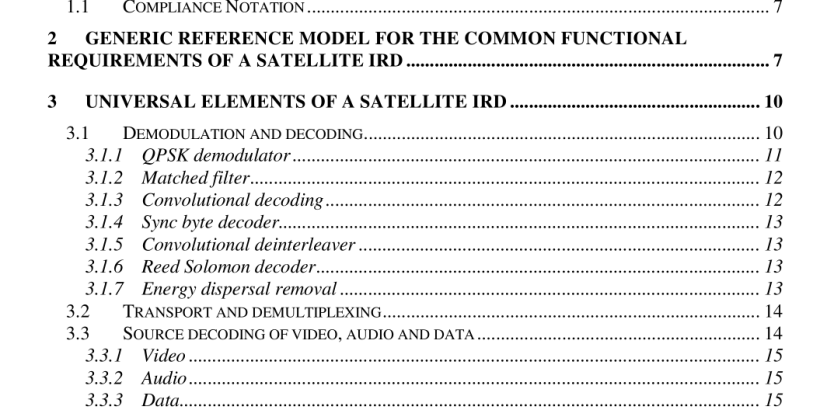ANSI SCTE 56-2016 pdf download.Digital Multiprogram Distribution by Satellite
Satellite Digital TV systems have shown their advantages with respect to the analog TV allowing a more efficient use of the satellite frequency spectrum available and establishing a more robust scenario with respect to interference protection. With the aim to promote the convergence on a worldwide standard for satellite digital multi- program reception systems for television, sound and data services, the systems for the reception of Digital Multiprogram Distribution by Satellite are described. These descriptions configure the universal elements of the satellite Integrated Receiver Decoder (IRD). The universal elements of the satellite IRD are capable of receiving emissions from System I, and System II. The common and specific elements of each system have been analyzed and it has been concluded on the feasibility of the implementation of the universal elements of a Satellite IRD. This document analyses the common elements among existing systems, defines and describes the functions of a generic system model and identifies the processes and the minimum set of parameters of the various sub-systems of the universal elements of a Satellite IRD. The feasibility of the implementation of the common elements in a satellite IRD has been demonstrated in consultation with the industry.
5.3.1 Synchronization characteristics for System I
The system input stream shall be organized in fixed length packets, following the MPEG-2 transport multiplexer (see ISO/IEC 13818-1 [1]). The total packet length of the MPEG-2 transport Multiplex (MUX) packet is 188 bytes. This includes 1 sync-word byte (i.e. 47 HEX ). The processing in order at the transmitting side shall always start from the MSB (i.e. “0”) of the sync word-byte (i.e. 01000111).
5.3.2 Synchronization characteristics for System II
The uplink transmission processing facilitates downlink synchronization of the FEC code system by performing MPEG-2 packet reordering and 16 bit frame sync and reserved word formatting. Fig. 12 shows the uplink processing required to ensure that the 16 bit frame sync pattern appears at the Viterbi decoder output in consecutive byte locations every 12 RS block intervals.
The convolutional interleaving process shall be based on the Forney approach which is compatible with the Ramsey type III approach, with I = 12. The interleaved frame shall be composed of overlapping error protected packets and shall be delimited by inverted or non- inverted MPEG-2 sync bytes (preserving the periodicity of 204 bytes). The interleaver may be composed of I = 12 branches, cyclically connected to the input byte- stream by the input switch. Each branch shall be a First-In, First-Out (FIFO) shift register, with depth (M j) cells (where M = 17 = N/I, N = 204 = error protected frame length, I = 12 = interleaving depth, j = branch index). The cells of the FIFO shall contain 1 byte, and the input and output switches shall be synchronized. For synchronization purposes, the sync bytes and the inverted sync bytes shall be always routed in the branch “0” of the interleaver (corresponding to a null delay). NOTE: The deinterleaver is similar, in principle, to the interleaver, but the branch indexes are reversed (i.e. j = 0 corresponds to the largest delay). The deinterleaver synchronization can be carried out by routing the first recognized sync byte in the “0” branch.
Loading of the sequence “100101010000000” into the PRBS registers, as indicated in Fig. 17, shall be initiated at the start of every eight transport packets. To provide an initialization signal for the descrambler, the MPEG-2 sync byte of the first transport packet in a group of eight packets is bit-wise inverted from 47 HEX to B8 HEX . This process is referred to as the “Transport Multiplex Adaptation”. The first bit at the output of the PRBS generator shall be applied to the first bit (i.e. MSB) of the first byte following the inverted MPEG-2 sync byte (i.e. B8 HEX ). To aid other synchronization functions, during the MPEG-2 sync bytes of the subsequent 7 transport packets, the PRBS generation shall continue, but its output shall be disabled, leaving these bytes unrandomized. Thus, the period of the PRBS sequence shall be 1 503 bytes. The randomization process shall be active also when the modulator input bit-stream is non- existent, or when it is non-compliant with the MPEG-2 transport stream format (i.e. 1 sync byte + 187 packet bytes). This is to avoid the emission of an unmodulated carrier from the modulator.ANSI SCTE 56-2016 pdf download
